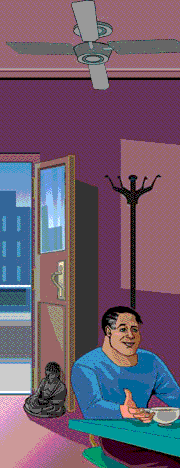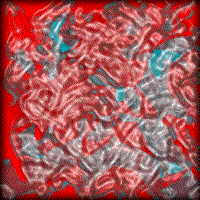

“I might say: if the place I want to get to could only be reached by way of a ladder, I would give up trying to get there. For the place I really have to get to is a place I must already be at now.” ~Ludwig Wittgenstein
Reportedly Aiden’s head was misshapen at birth, and his fraternal grandmother massaged it into an agreeable contour with patient care. He was a crying baby his first year, and disliked the touch of skin. He would not be held as an infant unless he was allowed to chew buttons on dresses, or was cradled in a pillow. As a young boy he struggled with left/right hand orientations, tying his shoes, telling time, and carsickness. He was also prone to bedwetting during these years, though was always an immaculate, soap-scrubbed child.
Aiden was born into a blue-collar southern family, but lost his southern accent while still young. Later he acquired a formal, idiosyncratic way of speaking that could only be attributed to public television and spotty reading. He drew cartoons from boyhood, built pretend spaceships out of wooden soft drink crates, and entertained cousins with puppet shows.
Indicative of his early development, he was able to self-hallucinate while lying in a dark room, where eidetic patterns and imagery flowed purely from thought. In similar repose, melodies were divined from ambient sounds, and many humming furnace fans provided raw material for a lullaby. When he invariably took up the guitar, and then the piano, it was as if he had previous knowledge of them. His talent, as in all other instances of it, was less a means of communication than a means by which a teenager retreated further into a hermitic, self-sustained world.

Self-reliance notwithstanding, Aiden was a lackluster student at the beginning, especially in math and grammar, and was placed in the “second reading group” until the sixth grade. His interests offset his deficits, with his gift for geography and an encyclopedic memory for trivia being exemplarily examples. Perhaps his most striking contradiction was, in spite of having a large vocabulary, he could barely write before entering college. Similarly, he had an aptitude for wordplay and puns, and whether in speech or composition, creative or logical thought, he was never at a loss to express his ideas.
As with many interests in his life, there was no true attraction in what Aiden chose to pursue prior to it becoming an obsession. He initially entered junior college at the urging of his mother and, on committing to the scheme of higher education, transferred to a four-year school. There he made marked improvement in all subjects, including math.
Essentially Aiden was an autodidact, and viewed college as a way to validate what he taught himself. His personal projects ran on a different track from his studies, and this was nowhere truer than during his time as a music composition major. He jumped from music composition to graphic art to fine art over a ten-year period, and on exiting the world of the university reinvented himself as an alternative cartoonist. This late metamorphosis naturally led to him becoming a writer, although he read little for an aspiring author.
By this evaluation Aiden was an overachiever when it came to personal goals, but an underachiever in all else. In sum, the breadth of his ability was as much a cause for distraction as it was a virtue. He could only be fanatical about one discipline at a time, making it all but impossible for him to multitask, prioritize, or envision a long-term goal. This compulsion partly explained why he never sought a career in anything he did, although his intolerance of criticism, and reluctance to share his accomplishments with others, equally contributed to this outcome.
His inability to focus on practical things was complicated by an obsequious, insecure nature, which made him a poor advocate for himself in business dealings. By necessity he made his living in a long string of low-paying jobs, and saw his meager existence as the price to pay for preserving his independence. Outside of art and related areas, there was little in the way of recreation, hobbies, or social interaction with others.
A brief flowering in graduate school brought him out of his shell, but the artist could never escape his acute anxieties, particularly in the social arena. Once he moved away from home, he taught himself how to cut his own hair to forgo need of a barber. He wanted to believe his many phobias were cultivated for artistic effect, yet the real and incapacitating consequences of them limited his life choices.
He was afraid of (among other things) heights, water, public gatherings, authority figures, strangers, travel, loud machinery, pressurized tanks of gas, unfamiliar locations, insects, small spaces, large animals, and attractive women. He was not completely immobilized by his fears, but a life of avoidance was easier than a life of confrontation. Regardless, being reclusive gave him only minimal protection from his demons: At night he was frequently afflicted by hypnagogic hallucinations, insomnia, and, in recent years, sleepwalking.
![]() Aiden’s fortunes began to turn after receiving a phone call in early September. He was fishing in his sofa for quarters to use at the laundromat when it came. At first silence was heard on the handset, and then what sounded like a pencil rolling off a desk. This was followed by a grunt and the squeaking of a chair. (Perhaps someone retrieved the pencil.) A loud voice started up in the middle of a conversation.
Aiden’s fortunes began to turn after receiving a phone call in early September. He was fishing in his sofa for quarters to use at the laundromat when it came. At first silence was heard on the handset, and then what sounded like a pencil rolling off a desk. This was followed by a grunt and the squeaking of a chair. (Perhaps someone retrieved the pencil.) A loud voice started up in the middle of a conversation.
“I have good news for you, Mr. Gauge,” the man declared. “Is this Mr. Aiden Gauge to whom I am speaking?”
The elderly sounding gentleman had an Eastern European accent, and clicking ceramic teeth. A little confused, Aiden went along. “Yes, it is.”
“Very good. Glad to hear it. Mr. Gauge, my name is Bedrich Reznicek, attorney at law, and I…” Just then another pencil (maybe the same one) was heard rolling off the desk, followed by another grunt and more squeaking. The man cleared his throat close to the receiver. “Mr. Gauge, are you still there?”
“I am.”
“Very good. Glad to hear it. I am in position to tell you, Mr. Gauge, being the attorney for an estate of a particular individual who has recently passed on, and whose name I cannot divulge as a legal matter, that you—Mr. Gauge—have been named as a beneficiary in this individual’s will. Is this not good news?”
“A beneficiary?”
“It was someone who collected your art.”
Aiden never exhibited much as a painter, and never bothered to collect the names of those few individuals who purchased his work.
Mr. Reznicek continued, “The estate has left you a rent-free studio, as well as a monthly stipend. This, of course, will require you relocating to take advantage of the situation.”
“Relocate? Where to?”
“It is a place called Stonesthrow, and is not far from Chicago. Have you heard of it?”
“I think so.”
The lawyer added a few details. “The house is a curiosity, as you will find. The builder made his reputation designing miniature golf courses in the Fifties and Sixties, and in its original construction the residence had no electricity. It has every amenity now. The property nearly burned down several decades ago and was subsequently rebuilt and wired to code.”
This information went no way toward clearing up the recipient’s befuddlement, and as quickly as the strange conversation started, it finished. The lawyer gave the painter his phone number and left him to think about the offer; Aiden called back within the hour to accept.
Stonesthrow was an hour away, and considered a distant suburb of Chicago. It was not so remote as all that, and it might be exactly what the artist needed to jump start his “career” as a painter. It was change—and any change was good. The stipend included an advance that allowed him to buy much needed art supplies. He could not take possession of the property until late October, so used the interval to finish one or two unfinished canvases that were collecting dust in his small apartment.
Chapter Two, Section Two/ Back/Contents Page
Copyright © 2007 Michael Teague. All rights reserved.